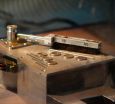(Press-News.org) MANHATTAN, Kan. -- Kansas State University researchers have discovered a molecule that may be capable of delivering drugs inside the body to treat diseases.
For the first time, researchers have designed and created a membrane-bounded vesicle formed entirely of peptides -- molecules made up of amino acids, the building blocks of protein. The membrane could serve as a new drug delivery system to safely treat cancer and neurodegenerative diseases.
A study led by John Tomich, professor of biochemistry at Kansas State University, has been published in the journal PLOS ONE in September, and a patent for the discovery is pending.
The peptides are a set of self-assembling branched molecules made up of naturally occurring amino acids. The chemical properties of a peptide create a vesicle that Tomich describes as a bubble: It's made up of a thin membrane and is hollow inside. Created in a water solution, the bubble is filled with water rather than air.
The peptides -- or bubbles -- can be made in a solution containing a drug or other molecule that becomes encapsulated as the peptide assembles, yielding a trapped compound, much like a gelatin capsule holds over-the-counter oral remedies. The peptide vesicles could be delivered to appropriate cells in the body to treat diseases and minimize potential side effects.
"We see this as a new way to deliver any kind of molecule to cells," Tomich said. "We know that in certain diseases subpopulations of cells have gone awry, and we'd like to be able to specifically target them instead of attacking every cell, including healthy ones."
The finding could improve gene therapy, which has the potential to cure diseases by replacing diseased cells with healthy ones. Gene therapy is being tested in clinical trials, but the biggest challenge is how best to deliver the genes.
Methods include cells with a virus being injected into the body, and liposomes -- fatty compounds -- carrying the genes. However, these methods may present some problems.
When a virus is used, the body's immune system can attack the virus or cause a tumor. Lipid-based systems may cause inflammation and may not properly bind to cells.
The peptides created by Kansas State University researchers have advantages over their lipid counterparts. The peptides have improved stability and durability, are easier and quicker to create, and they could be delivered to a specific area in the body.
The peptides can be designed to have the ability to target cells, tissues, tumors or organs, and to encapsulate chemical reagents, antibodies, toxins and inhibitors, Tomich said.
"We don't even begin to know all of the potential applications for this discovery," he said. "We envision that many products could be packaged and delivered using these peptides."
###Partial funding for the study came from the Kansas State University Johnson Cancer Research Center, National Institutes of Health and Japan Society for the Promotion of Science.
Kansas State University collaborators include Sushanth Gudlur, May 2012 doctoral graduate in biochemistry, who first published the results in a dissertation; Pinakin Sukthankar, doctoral student in biochemistry; Jian Gao, former postdoctoral fellow in the department of biochemistry; Luz Adriana Avila Flores, graduate research assistant in the department of biochemistry; Yasuaki Hiromasa, research assistant professor of biochemistry; and Jianhan Chen, assistant professor of biochemistry. Takeo Iwamoto from the Jikei University School of Medicine in Japan also was a collaborator.
Newly discovered molecule could deliver drugs to treat diseases
2012-09-24
ELSE PRESS RELEASES FROM THIS DATE:
A windshield wiper for Mars dust is developed
2012-09-24
This press release is available in Spanish.
VIDEO:
A team of researchers at Universidad Carlos III in Madrid has developed a device that works as a windshield wiper to eliminate Mars dust from the sensors on the NASA...
Click here for more information.
Leading energy scientists from the UK and China are joining forces to develop green technology that will revolutionise the way electricity ...
Gas outlets off Spitsbergen are no new phenomenon
2012-09-24
Frequent storms and sub-zero temperatures – nature drove the marine researchers that were assessing gas outlets on the sea bed off the coast of Spitsbergen for four and a half weeks to their limits. Nevertheless the participants were very pleased when they returned: "We were able to gather many samples and data in the affected area. With the submersible JAGO we even managed to form an impression of the sea bed and the gas vents" summarised the chief scientist Professor Dr. Christian Berndt from GEOMAR | Helmholtz Centre for Ocean Research Kiel.
The reason for the expedition ...
Therapeutic impact of cell transplantation aided by magnetic factor
2012-09-24
Putnam Valley, NY. (Sept. 24, 2012) – Two studies in the current issue of Cell Transplantation (21:6), now freely available on-line at http://www.ingentaconnect.com/content/cog/ct/, demonstrate how the use of magnetic particles are a factor that can positively impact on the targeted delivery of transplanted stem cells and to also provide better cell retention.
A research team from the University of British Columbia used focused magnetic stem cell targeting to improve the delivery and transport of mensenchymal stem cells to the retinas of test rats while researchers from ...
In birds' development, researchers find diversity by the peck
2012-09-24
Cambridge, Mass. - September 24, 2012 - It has long been known that diversity of form and function in birds' specialized beaks is abundant. Charles Darwin famously studied the finches on the Galapagos Islands, tying the morphology (shape) of various species' beaks to the types of seeds they ate. In 2010, a team of Harvard biologists and applied mathematicians showed that Darwin's finches all actually shared the same developmental pathways, using the same gene products, controlling just size and curvature, to create 14 very different beaks.
Now, expanding that work to ...
Scientists shed light on riddle of sun's explosive events
2012-09-24
DURHAM, N.H. – Four decades of active research and debate by the solar physics community have failed to bring consensus on what drives the sun's powerful coronal mass ejections (CMEs) that can have profound "space weather" effects on Earth-based power grids and satellites in near-Earth geospace.
In a paper just published in Nature Physics, an international team of space scientists, including a researcher from the University of New Hampshire's Space Science Center (SSC), explains the mysterious physical mechanisms underlying the origin of CMEs. Their findings, based on ...
When they do not all look alike: Using identity to reduce own-race bias
2012-09-24
September 24, 2012 - People often remark that people of a different race "all look alike." However, when we have trouble recognizing people from another race, it may actually have little to do with the other person's race. Instead, new research finds that that we can improve our memory of members of another race by identifying ourselves as part of the same group. Such identification could improve everything from race relations to eyewitness identification.
"One of the most robust phenomena in social perception is the finding that people are better at remembering people ...
Little evidence supports medical treatment options for adolescents with autism
2012-09-24
Vanderbilt University researchers are reporting today that there is insufficient evidence to support the use of medical interventions in adolescents and young adults with autism.
Despite studies that show that many adolescents and young adults with autism spectrum disorders are being prescribed medications, there is almost no evidence to show whether these medications are helpful in this population, the researchers said.
These findings are featured in the Sept. 24 issue of Pediatrics.
"We need more research to be able to understand how to treat core symptoms of autism ...
Media coverage influences value of presidential debates for viewers, study finds
2012-09-24
COLUMBUS, Ohio -- The presidential debates offer viewers a lot of substance about the issues of the campaign -- but postdebate media coverage can undermine the value they have for voters, a new study suggests.
Results showed that postdebate coverage that focused on the debate as a competition led viewers to think less about policy issues. By comparison, coverage that focused on the substance of the discussion increased the likelihood that viewers would come away with specific thoughts about candidates' policy proposals.
The researchers conducted two different studies ...
Scientific discovery offers 'green' solution in fight against greenhouse gases
2012-09-24
A low-cost new material that could lead to innovative technologies to tackle global warming has been discovered by scientists at The University of Nottingham.
The porous material, named NOTT-300, has the potential to reduce fossil fuel emissions through the cheaper and more efficient capture of polluting gases such as carbon dioxide (CO2) and sulphur dioxide (SO2). The research, published in the scientific journal Nature Chemistry, demonstrates how the exciting properties of NOTT-300 could provide a greener alternative to existing solutions to adsorb CO2 which are expensive ...
AIDS patients face risk for esophageal, stomach cancers
2012-09-24
People with AIDS are at increased risk for developing esophageal and stomach carcinoma as well as non-Hodgkin lymphomas (NHLs), according to a new study in Gastroenterology, the official journal of the American Gastroenterological Association.
"People diagnosed with AIDS are living longer due to improved therapies. However, they remain at increased risk of developing a number of different cancers," said E. Christina Persson, PhD, of the National Cancer Institute and lead author of this study. "An elevated risk of esophageal and stomach cancers had been observed before, ...

